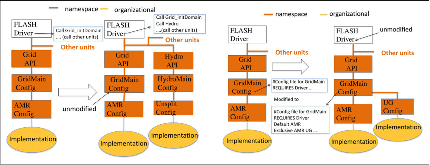The dividends of investing in computational software design: A case study
- MCS, Argonne National Laboratory, Argonne, IL, USA, Flash Center for Computational Science, University of Chicago, Chicago, IL, USA, Computation Institute, University of Chicago, Chicago, IL, USA
- Flash Center for Computational Science, University of Chicago, Chicago, IL, USA, Computation Institute, University of Chicago, Chicago, IL, USA, Argonne National Laboratory, Chicago, IL, USA, Department of Astronomy and Astrophysics, University of Chicago, Chicago, IL, USA
A significant fraction of computational software for scientific research grows through accretion. In a common scenario, a small group develops a code for a specific purpose. Others find the software useful, so they add to it for their own use. The software grows to the point where its management becomes intractable and scientific results obtained from it become unreliable. This is in stark contrast with a small number of scientific codes that have undergone a design process, be it due to an upfront investment, or when haphazardly grown codes have reset and started again. At a minimum, these codes reduce the time to obtain research results for the communities they serve because individual researchers do not have to develop their own codes. They provide further benefits; the results they produce are more reproducible due to greater scrutiny, leading to better science. One of the more overlooked benefits, which is perhaps of greater significance, is that a well-designed code can expand to serve communities beyond the ones it was designed for. Thus, research communities with similar computational requirements can symbiotically improve computation-based research for each other. In this article, we present a case study of FLASH, a code that was designed and developed for simulating thermonuclear runaways such as novae and type Ia supernovae in astrophysics. Designed to be modular and extensible, users from several diverse research areas have added capabilities to it and adapted it for their own communities. Examples include cosmology, high-energy density physics, core-collapse supernovae, star formation, fluid–structure interactions, and chemical combustion. We give a summary of design features that facilitated the expansion and quantify the effort needed to expand into some of the above-mentioned fields. We also quantify the impact on different communities by mining the database of publications using FLASH, collected by its developers.
- Research Organization:
- Argonne National Laboratory (ANL), Argonne, IL (United States)
- Sponsoring Organization:
- National Science Foundation (NSF); USDOE National Nuclear Security Administration (NNSA); University of Chicago
- Grant/Contract Number:
- AC02-06CH11357
- OSTI ID:
- 1414789
- Alternate ID(s):
- OSTI ID: 1530581
- Journal Information:
- International Journal of High Performance Computing Applications, Journal Name: International Journal of High Performance Computing Applications Vol. 33 Journal Issue: 2; ISSN 1094-3420
- Publisher:
- SAGE PublicationsCopyright Statement
- Country of Publication:
- United States
- Language:
- English
Web of Science
Similar Records
Basic Research Needs in The Science of Scientific Software Development and Use: Investment in Software is Investment in Science
Final Report on Community Solar Design Models for Consumer, Industry, & Utility Success








